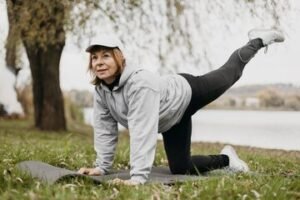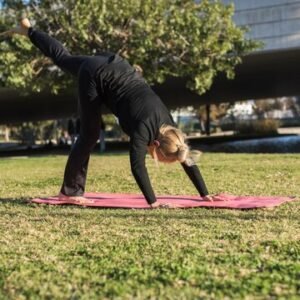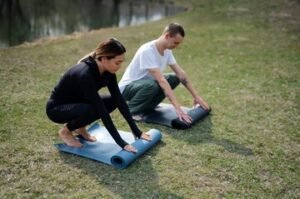Starting a fitness journey can be exciting, but it’s easy to feel overwhelmed with all the information out there. For beginners, outdoor exercises for beginners can be an excellent way to get started on your fitness path without the pressure of gym memberships or complicated routines. The fresh air, the freedom to move, and the opportunity to connect with nature make outdoor exercises a refreshing and enjoyable way to achieve your fitness goals.
In this article, we’ll discuss some simple and effective outdoor exercises for beginners and provide tips on how to stay on track without feeling overwhelmed. Whether you’re just starting or looking for a more sustainable way to stay fit, these exercises will help you build strength, endurance, and confidence as you progress toward your fitness goals.

Why Choose Outdoor Exercises for Beginners?
Outdoor exercises for beginners offer numerous benefits over indoor workouts. Not only do they allow you to enjoy the natural surroundings, but they also help alleviate feelings of being stuck in a gym environment. Nature has a way of boosting your mood and reducing stress, making it easier to stick with your fitness routine.
For beginners, outdoor exercises are often more approachable because they don’t require complex equipment or prior experience. You can start with simple activities that gradually increase in intensity as you build strength and endurance. The best part? Outdoor exercises for beginners can be done anywhere, whether it’s at a local park, in your backyard, or along a scenic trail.
1. Walking or Power Walking
One of the easiest and most effective outdoor exercises for beginners is walking. It’s low-impact, accessible, and can be done at any pace. Start with short walks around your neighborhood, or explore a local park or nature reserve. As you become more comfortable, you can increase your pace or add intervals of power walking to elevate your heart rate.
Walking is a great exercise to build cardiovascular health and endurance. It’s also an excellent way to reduce overwhelm because you can control the intensity. By starting slow and gradually increasing your distance and pace, you can stay on track without feeling like you’re overexerting yourself.
2. Jogging or Light Running
Once you’ve built up some endurance through walking, you can transition to jogging or light running. Outdoor exercises for beginners like jogging are ideal for improving cardiovascular fitness and toning muscles. It’s important to start slowly and avoid pushing yourself too hard. Begin with short jogs and alternate between walking and running, gradually increasing the running intervals as your stamina improves.
Running outdoors also provides a mental boost, as the change in scenery can make the workout feel less monotonous compared to running on a treadmill. When incorporating running into your routine, remember that consistency is key. Keep your expectations realistic and avoid pushing too hard to prevent injury and overwhelm.

3. Bodyweight Exercises
For a more structured workout, bodyweight exercises are an excellent option for outdoor exercises for beginners. These exercises require no equipment, and you can perform them in a park or even in your backyard. Some great bodyweight exercises to try include squats, lunges, push-ups, and planks.
You can create a simple circuit of bodyweight exercises that target different muscle groups. Start with a set of 10-15 repetitions for each exercise, then gradually increase the number as you build strength. This will help you avoid the feeling of overwhelm, as you can start with manageable sets and work your way up as you progress. Outdoor exercises for beginners like these are fantastic for building a balanced and strong body.
4. Cycling
Cycling is another excellent outdoor exercise for beginners. Whether you choose to ride on a stationary bike outdoors or head out for a bike ride along a scenic route, cycling provides a great cardio workout while strengthening the legs and improving balance.
For beginners, it’s important to start with short rides on flat terrain and gradually increase the intensity by adding hills or longer distances. Cycling allows you to cover more ground than walking and is a fun way to explore your surroundings while staying active. It also helps reduce the risk of burnout or overwhelm, as you can enjoy the ride at your own pace.

5. Hiking
If you enjoy nature, hiking is one of the best outdoor exercises for beginners. Whether you’re walking along a well-maintained trail or exploring a more rugged path, hiking provides both cardiovascular and strength benefits. The natural resistance from inclines, uneven ground, and elevation changes helps tone muscles, while the focus on the trail keeps your mind engaged.
Start with short, easy hikes on gentle terrain and gradually progress to more challenging trails as you build strength and confidence. Hiking offers a fantastic full-body workout, and because you’re immersed in nature, it can feel less like a workout and more like an adventure.
6. Stretching and Yoga
Incorporating stretching and yoga into your outdoor exercises for beginners routine can help increase flexibility and reduce the risk of injury. Whether you’re doing a gentle stretch routine in a park or following a yoga sequence on a beach, outdoor yoga offers a peaceful way to connect with your body and the environment.
These exercises are perfect for beginners because they allow you to go at your own pace. Start with simple stretches or basic yoga poses like downward dog, cat-cow, and child’s pose. As you gain flexibility and strength, you can challenge yourself with more advanced postures and routines. Outdoor exercises for beginners like these help to keep you grounded and focused, allowing you to avoid feeling overwhelmed by more intense workouts.
7. Jumping Jacks and Skipping
For a more dynamic cardio workout, jumping jacks and skipping are excellent outdoor exercises for beginners. They get your heart pumping and engage multiple muscle groups at once. These exercises are ideal for beginners because you can modify the intensity by adjusting your speed or duration.
Start with a set of 30 seconds of jumping jacks or skipping, then take a break. Gradually increase the duration as you become more comfortable and your endurance improves. These exercises are simple, fun, and effective at helping you meet your fitness goals without overwhelming you.
Tips to Avoid Overwhelm with Outdoor Exercises for Beginners
- Start Slow: The most important thing when beginning outdoor exercises is to pace yourself. It’s easy to get excited and overdo it, but starting slowly will help you avoid burnout and injuries.
- Set Realistic Goals: Instead of aiming for perfection, set small, achievable goals that you can build upon. For example, aim to walk for 20 minutes a few times a week and gradually increase the duration or intensity.
- Consistency Is Key: It’s not about doing everything perfectly; it’s about showing up regularly. Consistency is crucial in achieving your fitness goals without feeling overwhelmed.
- Listen to Your Body: Pay attention to your body’s signals. If you’re feeling too tired or sore, take a break or opt for a gentler activity. Avoid pushing yourself too hard in the beginning.
- Mix It Up: Keep your workouts interesting by varying your outdoor exercises for beginners. This will not only prevent boredom but also help target different muscle groups and keep you motivated.

Conclusion
Outdoor exercises for beginners are an excellent way to kickstart your fitness journey while avoiding the feeling of overwhelm. Whether you choose walking, cycling, or bodyweight exercises, the key is to start slow, set realistic goals, and stay consistent. These exercises will help you achieve your fitness goals, build strength and endurance, and improve your overall health—all while enjoying the fresh air and the beauty of nature. So, lace up your shoes, step outside, and begin your fitness journey today!




